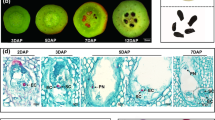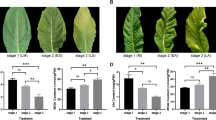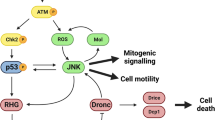Abstract
Petal senescence in flowering plants is a type of programmed cell death with highly regulated onset and progression. A NAM/ATAF1,2/CUC2 transcription factor, EPHEMERAL1 (EPH1), has been identified as a key regulator of petal senescence in Japanese morning glory (Ipomoea nil). Here we used a novel chemical approach to delay petal senescence in Japanese morning glory by inhibiting the DNA-binding activity of EPH1. A cell-free high-throughput screening system and subsequent bioassays found two tetrafluorophthalimide-based compounds, Everlastin1 and Everlastin2, that inhibited the EPH1–DNA interaction and delayed petal senescence. The inhibitory mechanism was due to the suppression of EPH1 dimerization. RNA-sequencing analysis revealed that the chemical treatment strongly suppressed the expression of programmed cell death- and autophagy-related genes. These results suggest that a chemical approach targeting a transcription factor can regulate petal senescence.
This is a preview of subscription content, access via your institution
Access options
Access Nature and 54 other Nature Portfolio journals
Get Nature+, our best-value online-access subscription
$32.99 / 30 days
cancel any time
Subscribe to this journal
Receive 12 digital issues and online access to articles
$119.00 per year
only $9.92 per issue
Buy this article
- Purchase on SpringerLink
- Instant access to full article PDF
Prices may be subject to local taxes which are calculated during checkout





Similar content being viewed by others
Data availability
All data generated or analysed in this study are included in this published article and its supplementary information files. Raw RNA-seq data are available at DDBJ Sequence Read Archive (https://www.ddbj.nig.ac.jp/dra/index-e.html, with accession numbers DRR437987–DRR437998, DRR545318–DRR545320). The I. nil genome (RefSeq assembly accession: GCF_001879475.1) was used for the sequencing analysis. Source data are provided with this paper.
References
Primack, R. B. Longevity of individual flowers. Annu. Rev. Ecol. Syst. 16, 15–37 (1985).
Ashman, T. L. & Schoen, D. J. How long should flowers live. Nature 371, 788–791 (1994).
van Doorn, W. G. & Woltering, E. J. Physiology and molecular biology of petal senescence. J. Exp. Bot. 59, 453–480 (2008).
Rogers, H. J. From models to ornamentals: how is flower senescence regulated? Plant Mol. Biol. 82, 563–574 (2013).
Shibuya, K., Niki, T. & Ichimura, K. Pollination induces autophagy in petunia petals via ethylene. J. Exp. Bot. 64, 1111–1120 (2013).
Jones, M. L. Mineral nutrient remobilization during corolla senescence in ethylene-sensitive and -insensitive flowers. AoB Plants 5, plt023 (2013).
Shibuya, K., Yamada, T. & Ichimura, K. Morphological changes in senescing petal cells and the regulatory mechanism of petal senescence. J. Exp. Bot. 67, 5909–5918 (2016).
Yamada, T., Takatsu, Y., Kasumi, M., Ichimura, K. & van Doorn, W. G. Nuclear fragmentation and DNA degradation during programmed cell death in petals of morning glory (Ipomoea nil). Planta 224, 1279–1290 (2006).
Matile, P. & Winkenbach, F. Function of lysosomes and lysosomal enzymes in the senescing corolla of the morning glory (Ipomoea purpurea). J. Exp. Bot. 22, 759–771 (1971).
Rogers, H. J. Programmed cell death in floral organs: how and why do flowers die? Ann. Bot. 97, 309–315 (2006).
Shibuya, K., Shimizu, K., Niki, T. & Ichimura, K. Identification of a NAC transcription factor, EPHEMERAL1, that controls petal senescence in Japanese morning glory. Plant J. 79, 1044–1051 (2014).
Olsen, A. N., Ernst, H. A., Lo Leggio, L. & Skriver, K. NAC transcription factors: structurally distinct, functionally diverse. Trends Plant Sci. 10, 79–87 (2005).
Mathew, I. E. & Agarwal, P. May the fittest protein evolve: favoring the plant-specific origin and expansion of NAC transcription factors. Bioessays 40, e1800018 (2018).
Ernst, H. A., Olsen, A. N., Larsen, S. & Lo Leggio, L. Structure of the conserved domain of ANAC, a member of the NAC family of transcription factors. EMBO Rep. 5, 297–303 (2004).
Olsen, A. N., Ernst, H. A., Lo Leggio, L. & Skriver, K. DNA-binding specificity and molecular functions of NAC transcription factors. Plant Sci. 169, 785–797 (2005).
Kjaersgaard, T. et al. Senescence-associated barley NAC (NAM, ATAF1,2, CUC) transcription factor interacts with radical-induced cell death 1 through a disordered regulatory domain. J. Biol. Chem. 286, 35418–35429 (2011).
Jensen, M. K. et al. The Arabidopsis thaliana NAC transcription factor family: structure–function relationships and determinants of ANAC019 stress signalling. Biochem. J. 426, 183–196 (2010).
Henley, M. J. & Koehler, A. N. Advances in targeting ‘undruggable’ transcription factors with small molecules. Nat. Rev. Drug Discov. 20, 669–688 (2021).
Lambert, S. A. et al. The human transcription factors. Cell 172, 650–665 (2018).
Koehler, A. N. A complex task? Direct modulation of transcription factors with small molecules. Curr. Opin. Chem. Biol. 14, 331–340 (2010).
Nomura, S. et al. Pyrrothiogatain acts as an inhibitor of GATA family proteins and inhibits Th2 cell differentiation in vitro. Sci. Rep. 9, 17335 (2019).
Yano, T. et al. AGIA tag system based on a high affinity rabbit monoclonal antibody against human dopamine receptor D1 for protein analysis. PLoS ONE 11, e0156716 (2016).
Zhang, J. H., Chung, T. D. Y. & Oldenburg, K. R. A simple statistical parameter for use in evaluation and validation of high throughput screening assays. J. Biomol. Screen 4, 67–73 (1999).
Shinozaki, Y. et al. Expression of an AtNAP gene homolog in senescing morning glory (Ipomoea nil) petals of two cultivars with a different flower life span. J. Plant Physiol. 171, 633–638 (2014).
Kim, J. H. et al. Trifurcate feed-forward regulation of age-dependent cell death involving miR164 in Arabidopsis. Science 323, 1053–1057 (2009).
Luo, J. et al. SMRT and Illumina RNA sequencing and characterization of a key NAC gene LoNAC29 during the flower senescence in Lilium oriental ‘Siberia’. Genes 12, 869 (2021).
Smith, M. T., Saks, Y. & van Staden, J. Ultrastructural-changes in the petals of senescing flowers of Dianthus caryophyllus L. Ann. Bot. 69, 277–285 (1992).
van Doorn, W. G., Kirasak, K. & Ketsa, S. Macroautophagy and microautophagy in relation to vacuole formation in mesophyll cells of Dendrobium tepals. J. Plant Physiol. 177, 67–73 (2015).
Lin, Y. Y. & Jones, M. L. CRISPR/Cas9-mediated editing of Autophagy Gene 6 in petunia decreases flower longevity, seed yield, and phosphorus remobilization by accelerating ethylene production and senescence-related gene expression. Front. Plant Sci. 13, 840218 (2022).
Wang, W. X., Vinocur, B., Shoseyov, O. & Altman, A. Role of plant heat-shock proteins and molecular chaperones in the abiotic stress response. Trends Plant Sci. 9, 244–252 (2004).
Sun, W. N., Van Montagu, M. & Verbruggen, N. Small heat shock proteins and stress tolerance in plants. Biochim. Biophys. Acta 1577, 1–9 (2002).
Marrs, K. A. The functions and regulation of glutathione S-transferases in plants. Annu. Rev. Plant Physiol. Plant Mol. Biol. 47, 127–158 (1996).
Schuler, M. A. Plant cytochrome P450 monooxygenases. Crit. Rev. Plant Sci. 15, 235–284 (1996).
Shibuya, K., Watanabe, K. & Ono, M. CRISPR/Cas9-mediated mutagenesis of the EPHEMERAL1 locus that regulates petal senescence in Japanese morning glory. Plant Physiol. Biochem. 131, 53–57 (2018).
Battelli, R. et al. Changes in ultrastructure, protease and caspase-like activities during flower senescence in Lilium longiflorum. Plant Sci. 180, 716–725 (2011).
Yamada, T. & Marubashi, W. Overproduced ethylene causes programmed cell death leading to temperature-sensitive lethality in hybrid seedlings from the cross Nicotiana suaveolens x N. tabacum. Planta 217, 690–698 (2003).
Shibuya, K., Yamada, T., Suzuki, T., Shimizu, K. & Ichimura, K. InPSR26, a putative membrane protein, regulates programmed cell death during petal senescence in Japanese morning glory. Plant Physiol. 149, 816–824 (2009).
Acknowledgements
We thank the Applied Protein Research Laboratory at Ehime University for protein analysis, the Drug Discovery Initiative at the University of Tokyo for providing the chemical libraries and the National BioResource Project ‘Morning glory’, Japan, for providing seeds of I. nil. We also thank M. Nakayama (National Agriculture and Food Research Organization) for valuable discussions about chemical structures, and K. Maruyama (Ehime University) for assistance with in vitro interaction assays. This work was supported by a grant from a commissioned project study on ‘Development of post-harvest technology in cut flowers’ (JP15650941 to K.S.) from the Ministry of Agriculture, Forestry and Fisheries, Japan.; the Platform Project for Supporting Drug Discovery and Life Science Research (Basis for Supporting Innovative Drug Discovery and Life Science Research) from Japan Agency for Medical Research and Development (AMED) under grant numbers JP21am0101086 (support number 1590 to K.S.) and JP21am0101077 (support number 1144 to K.S.); and a Grant-in-Aid for Scientific Research on Innovative Areas (JP16H06579 to T.S.), Grants-in-Aid for Scientific Research (21K05589 to K.S., 19H03218 to T.S. and 19K05815 to A.N.) from the Japan Society for the Promotion of Science.
Author information
Authors and Affiliations
Contributions
K.S., A.N. and T.S. designed experiments. K.S. and A.N. performed chemical screening. A.N., C.T. and K.S. performed in vitro interaction assays. K.S. performed the experiments with Japanese morning glory plants and RNA-seq analysis. K.S., A.N. and T.S. analysed and interpreted data. K.S. and A.N. wrote the manuscript, and all authors contributed to editing.
Corresponding authors
Ethics declarations
Competing interests
The authors declare no competing interests.
Peer review
Peer review information
Nature Plants thanks Junping Gao and the other, anonymous, reviewer(s) for their contribution to the peer review of this work.
Additional information
Publisher’s note Springer Nature remains neutral with regard to jurisdictional claims in published maps and institutional affiliations.
Extended data
Extended Data Fig. 1 Chemical structures of G1-1 and its analogues.
The inhibition assay of EPH1–DNA interaction activity was performed in the presence of G1-1 analogues at a final concentration of 5 µM.
Extended Data Fig. 2 Inhibition rate of EPH1–DNA interaction activity for fluorine-substituted compounds of G1-5 and G1-6.
a, b, Chemical structures (a) and the inhibition rate of EPH1–DNA interaction activity (b) for fluorine-substituted compounds of G1-5. c, d, Chemical structures (c) and the inhibition rate of EPH1–DNA interaction activity (d) for fluorine-substituted compounds of G1-6. The inhibition assays were performed in the presence of compounds at a final concentration of 10 µM. Values are means ± s.e.m. of n = 3 independent experiments (b, d). Asterisks indicate significant differences. **** P < 0.0001; one-way ANOVA with Dunnett’s test compared with G1-5 (b) or G1-6 (d).
Extended Data Fig. 3 Effects of Everlastin1 and Everlastin2 on the DNA interaction of NAC TFs other than EPH1.
a, Alignment of EPH1 (GenBank Accession No. AB849126), Arabidopsis ORE1 (NM_123323), and Lilium LhNAP (LC807006) polypeptide sequences. Identical amino acids are shown in reverse type. The overline indicates the conserved DNA-binding domain. b, Phylogenic tree of EPH1, Arabidopsis ORE1 and Lilium LhNAP proteins. Sequence alignment with ClustalW2 and phylogenic tree analysis with the neighbor-joining method were performed using Geneious Prime software (Biomatters, Auckland, New Zealand). c, Interaction assay for NAC TFs and DNA. Interactions between DNA and full-length ORE1 or LhNAP in the presence of Everlastin1 or Everlastin2 (5 µM each) were analyzed. DNA–protein interactions were analyzed using the AlphaScreen (AS) technology. Values are means ± s.e.m. of n = 4 independent experiments. Asterisks indicate significant differences. ns, not significant; **** P < 0.0001; one-way ANOVA with Dunnett’s test compared with DMSO.
Extended Data Fig. 4 Effects of Everlastin1 and Everlastin2 on petal senescence.
a, Petal segments treated with Everlastin1 or Everlastin2. Petal segments of I. nil were floated adaxial side up in DMSO control or Everlastin1 or Everlastin2 solutions at a final concentration of 5 µM. The pictures show petal segments at 24 h after flower opening (t24). Petal segments in the DMSO control showed water-soaking symptoms. Petal segments were prepared from five different flowers per treatment (Petri dish) and photographs of representative sets from at least three independent experiments are shown (a). b, Gel image of DNA degradation in petal segments treated with Everlastin1 or Everlastin2. A representative photograph from three biological replicates is shown. c, Cut flowers of I. nil treated with Everlastin2. Whole cut flowers were floated in Everlastin2 solution at a final concentration of 5 µM. The picture shows flowers at t24. A representative photograph from six biological replicates is shown.
Extended Data Fig. 5 Effects of Everlastin1 and Everlastin2 on petal senescence and gene expression in EPH1-knockout plants.
a, Time-course of visible senescence of the petal segments in EPH1-knockout (EPH1-KO) plants. Petal segments were floated adaxial side up in the DMSO control, Everlastin1, or Everlastin2 solution at a final concentration of 5 µM. Petal segments were prepared from five different flowers per treatment (Petri dish) and photographs of representative sets from at least three independent experiments are shown. b, Venn diagrams showing the overlap of the up-regulated (log2 fold change >1) and down-regulated (log2 fold change <−1) genes between EPH1-KO and Everlastin1 or Everlastin2 treatment compared to DMSO-treated WT control at t8. c, Volcano plot showing differentially expressed genes between EPH1-KO and Everlastin1-treated petal segments at t8. Red and blue plots indicate up-regulated (log2 fold change >1 and p-value < 0.05) and down-regulated (log2 fold change <−1 and p-value < 0.05) genes, respectively. p-value, Benjamini-Hochberg adjusted p-value. RNA-seq analysis was performed using three biological replicates per condition (b, c).
Supplementary information
Supplementary Information
Supplementary Fig. 1, Table 2 and unprocessed blot of Fig. 1.
Supplementary Table 1
Differentially expressed genes between EPH1-KO and Everlastin1-treated petal segments.
Supplementary Table 3
Exact P values.
Source data
Source Data Fig. 1
Statistical source data.
Source Data Fig. 2
Statistical source data.
Source Data Fig. 3
Statistical source data.
Source Data Fig. 4
Statistical source data.
Source Data Fig. 5
Statistical source data.
Source Data Fig. 1
Unprocessed blot.
Source Data Fig. 2
Unprocessed blot.
Source Data Extended Data Fig. 2
Statistical source data.
Source Data Extended Data Fig. 3
Statistical source data.
Rights and permissions
Springer Nature or its licensor (e.g. a society or other partner) holds exclusive rights to this article under a publishing agreement with the author(s) or other rightsholder(s); author self-archiving of the accepted manuscript version of this article is solely governed by the terms of such publishing agreement and applicable law.
About this article
Cite this article
Shibuya, K., Nozawa, A., Takahashi, C. et al. A chemical approach to extend flower longevity of Japanese morning glory via inhibition of master senescence regulator EPHEMERAL1. Nat. Plants 10, 1377–1388 (2024). https://doi.org/10.1038/s41477-024-01767-z
Received:
Accepted:
Published:
Issue date:
DOI: https://doi.org/10.1038/s41477-024-01767-z
This article is cited by
-
Small molecules inhibiting EPHEMERAL1 to extend flower longevity by regulating petal senescence
Plant Cell Reports (2025)



